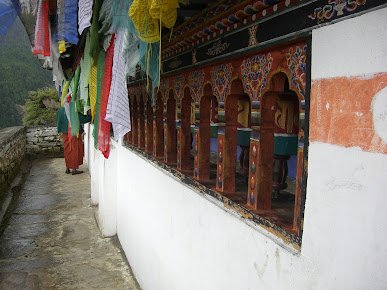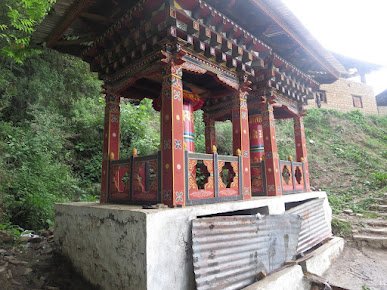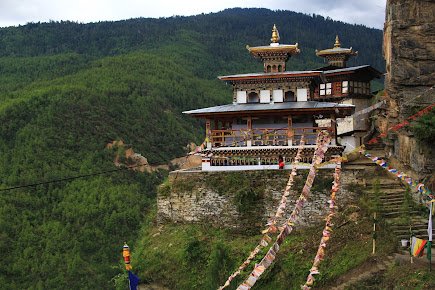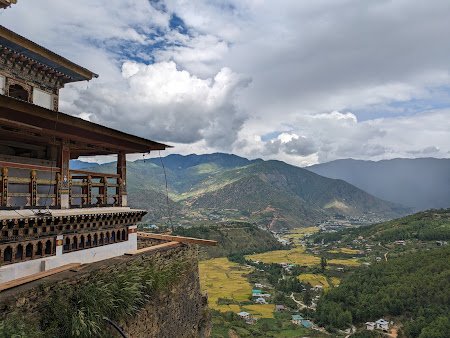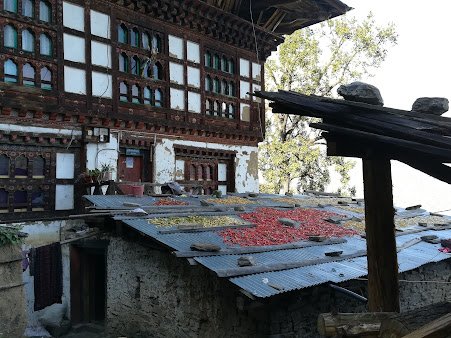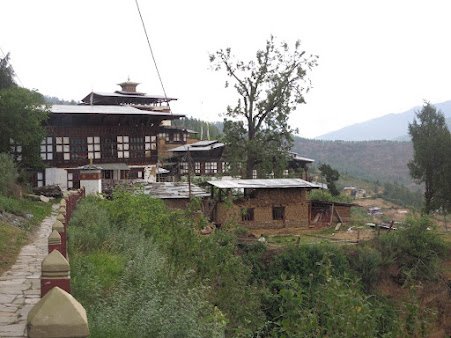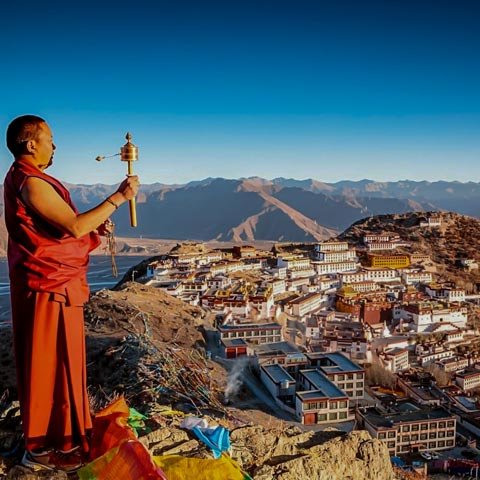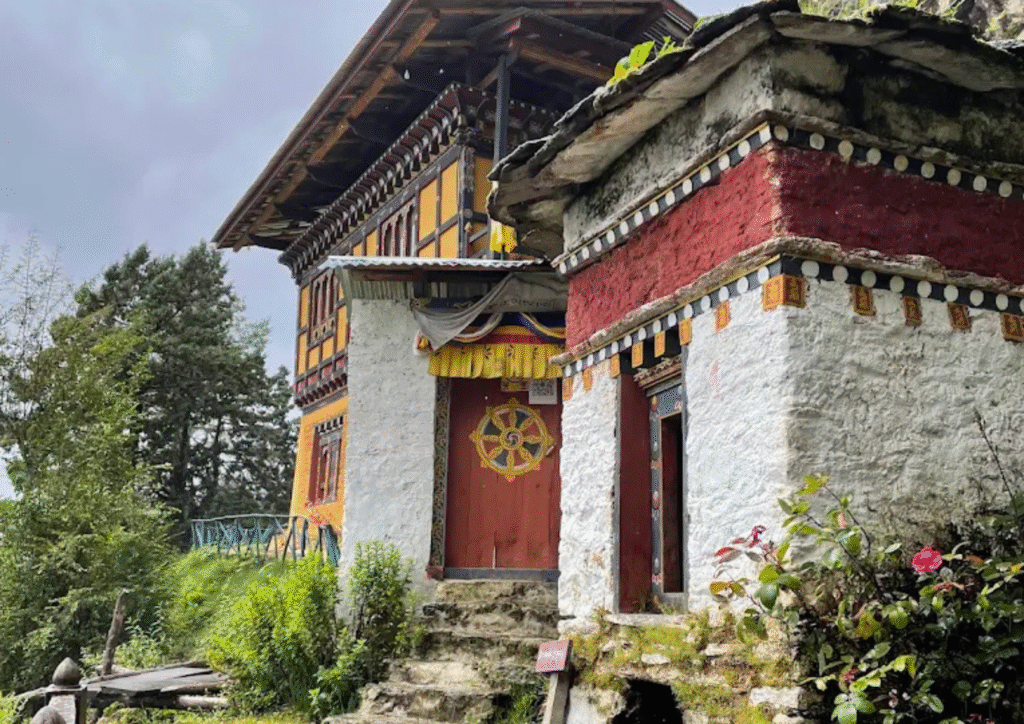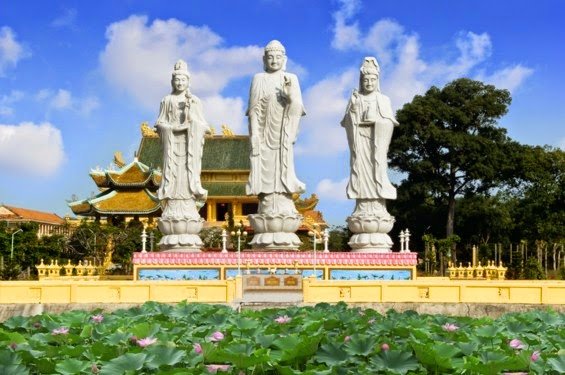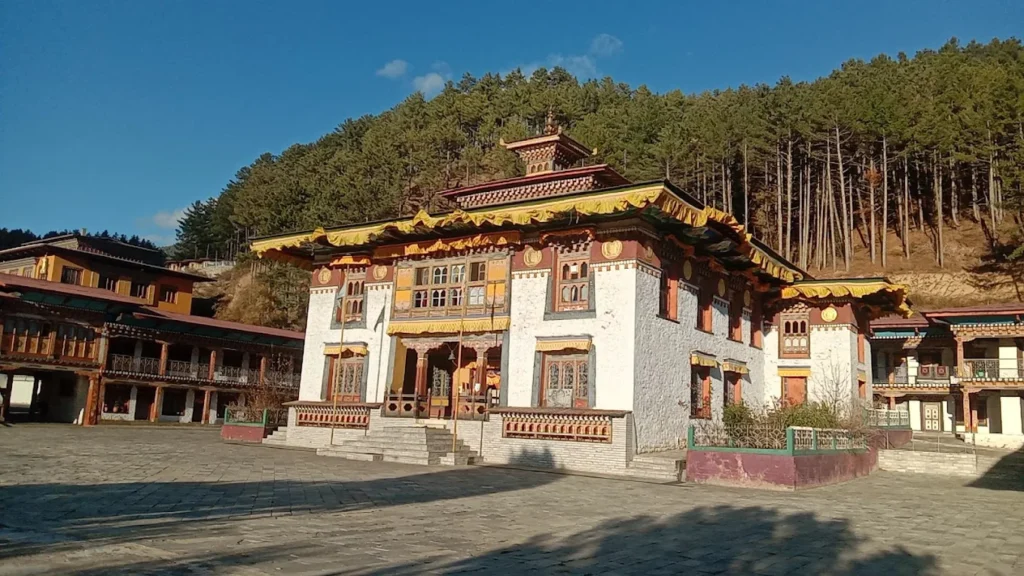Dzongdrakha Goemba: The Hidden Cliffside Sanctuary
Overview and Significance
Essence of Dzongdrakha Goemba
Tucked into a cliffside above Bhutan’s Paro Valley, Dzongdrakha Goemba, often called the “Little Tiger’s Nest,” is a serene cluster of temples that exudes quiet sanctity. Built in the 16th century, this lesser-known monastery clings to a rocky outcrop, its whitewashed walls and red-tiled roofs blending with the rugged terrain. Revered for its association with Drubthob Namgyal, a revered saint, it offers a tranquil escape from Paro’s busier sites, drawing pilgrims and adventurers seeking solitude. Dzongdrakha’s intimate scale and breathtaking perch make it a hidden gem, radiating spiritual calm amid the Himalayas.
- Defining Trait: A cliffside retreat, dubbed “Little Tiger’s Nest” for its serene perch.
- Spiritual Role: A meditative haven tied to Bhutanese Buddhist saints.
- Visitor Appeal: A peaceful destination for introspective travelers and cultural explorers.
Unlike the iconic Paro Taktsang, Dzongdrakha’s obscurity preserves its meditative ambiance, with prayer flags fluttering against a backdrop of pine forests and distant peaks. Its small size fosters a personal connection, as visitors wander its courtyards, enveloped by the scent of incense and the hum of monk chants. For locals, it’s a sacred retreat; for outsiders, it’s a glimpse into Bhutan’s understated spiritual depth.
Historical Evolution
Dzongdrakha Goemba was founded in the 16th century by Drubthob Namgyal, a disciple of the Drukpa lineage, who meditated in its caves to attain enlightenment. The monastery, built around these sacred sites, grew into a cluster of four main temples under the patronage of local chieftains. Despite its age, it has largely escaped major destruction, with minor renovations maintaining its original character. Its remote location has shielded it from over-tourism, preserving its historical integrity.
- Key Milestones:
- 16th Century: Drubthob Namgyal establishes the goemba around meditation caves.
- 18th Century: Local patrons expand the complex, adding secondary shrines.
- 20th Century: Minor repairs reinforce cliffside foundations.
- Ongoing: Monks and villagers upkeep the site with traditional methods.
Legends tell of Namgyal’s miracles, including taming wild spirits in the cliffs, which locals believe protect the goemba from harm. Unlike larger dzongs, Dzongdrakha’s history is marked by continuity, its small community of monks sustaining its rituals. Recent efforts to stabilize the cliff have used local stone, ensuring the goemba’s harmony with its environment.
Cultural Impact
Dzongdrakha Goemba is a cultural anchor for Paro’s rural communities, serving as a pilgrimage site where locals pray for health and prosperity. Its annual festival, though modest, features cham dances and offerings, uniting nearby villages in celebration. The goemba’s caves, believed to hold Namgyal’s spiritual energy, draw devotees seeking meditative retreats.
- Local Role: A pilgrimage hub for rural Bhutanese seeking blessings.
- Cultural Symbol: Represents Bhutan’s tradition of cliffside sanctuaries.
- Global Influence: Appeals to niche travelers and Buddhist scholars.
Globally, Dzongdrakha is less known, but its “Little Tiger’s Nest” moniker attracts adventurous tourists via travel blogs and niche guides. Its caves intrigue scholars of Vajrayana Buddhism, who study its links to Drukpa masters. Bhutan’s regulated tourism ensures the goemba remains unspoiled, its cultural significance intact for those who venture to its heights.
Signature Legacy
Dzongdrakha’s legacy is rooted in Drubthob Namgyal’s meditative feats, with legends claiming he left imprints in the caves’ rocks. The main temple, dedicated to Guru Rinpoche, houses a statue believed to grant clarity to meditators, cementing the goemba’s reputation as a spiritual haven. Locals tell of pilgrims experiencing visions in the caves, reinforcing its mystical allure.
- Mystical Caves: Imprints tied to Namgyal’s meditations.
- Guru Statue: A focal point for spiritual clarity.
- Local Tales: Stories of visions and healings in the caves.
One anecdote recounts a 19th-century monk who, after meditating in Dzongdrakha’s caves, resolved a village dispute with newfound wisdom, attributing it to the goemba’s energy. Such tales make Dzongdrakha a place of spiritual transformation, its legacy preserved in Paro’s oral traditions. Pilgrims leave offerings at the caves, seeking to tap into its enduring power.
Community and Global Reach
Dzongdrakha binds nearby villages, with farmers offering butter and rice to support its monks. The goemba’s small monastic community, often just a handful of monks, maintains its rituals, mentoring novices from local families. Globally, it attracts intrepid pilgrims and trekkers, drawn by its cliffside beauty and historical significance.
- Community Engagement: Villagers sustain the goemba with offerings.
- Monastic Role: Monks guide rituals and preserve caves’ sanctity.
- Global Visitors: Appeals to adventurers and Buddhist practitioners.
Bhutan’s diaspora shares Dzongdrakha’s stories, while niche travel platforms highlight its tranquility. Conservationists, aware of its cliffside fragility, advocate minimal intervention to preserve its authenticity. Bhutan’s visitor limits ensure Dzongdrakha remains a serene retreat, its reach growing slowly but meaningfully.
Architectural Features
Distinctive Design
Dzongdrakha Goemba’s architecture is a delicate balance of Bhutanese tradition and cliffside necessity, with four small temples clinging to a rocky ledge. Their whitewashed mud walls, topped with red tiles, meld with the cliff, creating a seamless integration with nature. The compact layout, centered around a courtyard, prioritizes spiritual intimacy over grandeur, reflecting the goemba’s meditative purpose.
- Cliffside Harmony: Temples blend with the rocky terrain.
- Minimalist Aesthetic: White walls and red tiles evoke simplicity.
- Courtyard Focus: Fosters communal prayer and reflection.
Narrow paths, carved into the cliff, connect the temples, with prayer flags adding bursts of color. The design, adapted from Paro Taktsang, uses timber beams anchored into rock, showcasing 16th-century ingenuity. Dzongdrakha’s scale, though small, amplifies its serene ambiance, its architecture a testament to Bhutan’s cliffside devotion.
Signature Structures
The main temple, dedicated to Guru Rinpoche, houses a gilded statue, its altar adorned with butter lamps and thangkas. A secondary shrine, honoring Drubthob Namgyal, contains a meditation cave with rock imprints, accessible to pilgrims on special days. The courtyard’s chorten, encircled by prayer wheels, serves as a focal point for circumambulation.
- Guru Temple: Centers on a revered Rinpoche statue.
- Namgyal Shrine: Features a sacred meditation cave.
- Chorten: A pilgrimage hub for prayers and offerings.
A small bell tower, its bronze chime rung during rituals, adds a melodic note to the cliffside silence. Wooden balconies, carved with lotus motifs, offer dizzying valley views, their craftsmanship enduring despite exposure. These structures, though modest, create a cohesive spiritual enclave, each element enhancing Dzongdrakha’s sanctity.
Artisanal Mastery
Dzongdrakha’s craftsmanship reflects Bhutan’s sacred artistry on a small scale. Murals in the Guru Temple, painted with mineral pigments, depict Rinpoche’s eight manifestations, their faded hues glowing softly. Thangkas, hung during festivals, feature silk-embroidered deities, crafted by local women. Wooden altars, etched with cloud patterns, showcase Paro’s woodworking heritage.
- Murals: Vibrant yet faded, using reds and blues.
- Thangkas: Intricate textiles for ritual use.
- Woodwork: Carvings symbolize spiritual harmony.
Maintenance relies on local artisans, who mix pigments by hand and source timber from nearby forests. The red tiles, fired in village kilns, are replaced every few decades, a labor of devotion. These crafts, though simple, ensure Dzongdrakha’s visual charm endures, its artistry a quiet prayer to its founders.
Hidden Architectural Gems
Dzongdrakha’s subtler features captivate the attentive. A rock niche near the Namgyal shrine, etched with mantras, is believed to mark Namgyal’s meditation spot, drawing quiet reverence. Prayer wheels, embedded in cliffside walls, spin with a gentle creak, their bronze worn by pilgrims’ hands. A tiny garden, tucked behind the chorten, blooms with wildflowers, offering a serene retreat.
- Mantra Niche: A sacred marker of Namgyal’s presence.
- Prayer Wheels: Tactile links to devotion.
- Wildflower Garden: A hidden haven of color.
These elements, often missed, enrich Dzongdrakha’s allure. The niche’s inscriptions invite contemplation, while the prayer wheels’ rhythm soothes. The garden, tended by monks, adds a touch of life to the cliff, its blooms a symbol of resilience.
Preservation and Evolution
Preserving Dzongdrakha is challenging due to its cliffside perch. Recent efforts have reinforced foundations with stone, countering monsoon erosion. Artisans train in traditional mural techniques, using Himalayan minerals to retouch faded art. The cliff’s instability requires regular checks, funded by local donations.
- Cliff Reinforcement: Stabilizes temples with stone.
- Artisan Skills: Preserve murals and woodwork.
- Environmental Risks: Monsoons and rockfalls threaten stability.
Bhutan’s government limits interventions, avoiding over-restoration to maintain authenticity. Solar-powered lanterns, discreetly placed, reduce candle use, minimizing fire risks. These efforts ensure Dzongdrakha remains a living sanctuary, its architecture balancing fragility and endurance.
Rituals and Practices
Sacred Daily Rites
Each dawn, Dzongdrakha’s monks chant mantras in the Guru Temple, their voices echoing off the cliff. Butter lamps, lit before Rinpoche’s statue, cast a warm glow, symbolizing wisdom. Monks offer water bowls, their delicate placement purifying the shrines, setting a meditative tone.
- Morning Chants: Recite prayers like “Om Mani Padme Hum.”
- Butter Lamps: Symbolize enlightenment’s light.
- Offerings: Water bowls cleanse sacred spaces.
The rituals’ intimacy, amplified by the cliff’s silence, creates a profound atmosphere. Visitors, though restricted from inner shrines, hear chants through open doors, feeling the goemba’s spiritual pulse. Dzongdrakha’s daily rites, though small-scale, anchor its sanctity.
Unique Spiritual Practices
Dzongdrakha’s practices focus on Namgyal and Rinpoche. Pilgrims circumambulate the chorten, spinning prayer wheels for merit. Some offer khatas to the Guru statue, praying for clarity, their scarves draping the altar in white. On rare occasions, monks open the Namgyal cave, allowing devotees to meditate in its sacred confines.
- Circumambulation: A meditative walk around the chorten.
- Khata Offerings: Symbolize devotion and purity.
- Cave Meditation: A transformative privilege for pilgrims.
These practices, rooted in Vajrayana, foster a deep connection to Dzongdrakha’s saints. The cave’s silence, locals say, sharpens spiritual focus, with some reporting visions. For devotees, these acts make the goemba a place of inner awakening.
Vibrant Festival Traditions
Dzongdrakha’s annual festival, held in autumn, honors Namgyal with cham dances and butter offerings. Monks craft torma, dough figures to appease spirits, while villagers perform traditional dances, their colorful ghos swaying. The event, though small, unites nearby communities, filling the cliff with song and prayer.
- Cham Dances: Depict spiritual narratives with masks.
- Torma Rituals: Offerings for harmony.
- Community Role: Unites villagers in celebration.
Other occasions, like Losar, see quieter rites, with monks praying for prosperity. Visitors during the festival witness Dzongdrakha’s warmth, as families share tea amid prayer flags. The contrast between the cliff’s austerity and the festive joy creates a memorable experience.
Visitor Engagement
Visitors can join simple rituals, enhancing their experience. Lighting butter lamps, available for donations, lets tourists pray alongside locals. Spinning prayer wheels offers a tactile connection, their hum soothing. Guides teach basic mantras, allowing visitors to chant during circumambulation.
- Butter Lamps: An accessible act of devotion.
- Prayer Wheels: Spinning accrues merit.
- Mantra Chanting: Deepens spiritual engagement.
These acts bridge cultural divides, letting outsiders share Dzongdrakha’s spirit. Photography is restricted inside shrines, but courtyard shots capture the cliffside beauty. The act of reaching the goemba, after a short trek, feels like a pilgrimage, rewarding effort with serenity.
Monastic and Community Roles
Dzongdrakha’s small monastic community, often just a few monks, leads rituals and tends shrines, mentoring novices from nearby villages. They bless amulets, which locals wear for protection. Villagers support the goemba, donating food and cleaning courtyards, seeing it as a sacred duty.
- Monastic Duties: Chanting, teaching, and shrine upkeep.
- Community Support: Sustains Dzongdrakha’s vitality.
- Cultural Continuity: Preserves local traditions.
During festivals, monks lead prayers, linking the goemba to surrounding hamlets. Villagers, especially women, organize offerings, their devotion palpable. This symbiosis ensures Dzongdrakha’s role as a spiritual heart endures.
Visitor Information
Navigating to Dzongdrakha Goemba
Dzongdrakha Goemba lies 8 km from Paro town, near Bondey village, a 20-minute drive followed by a 30-minute trek. The trailhead, marked by prayer flags, ascends through pine forests, with the goemba’s cliffside perch visible midway. Landmarks include a chorten at Bondey and the valley’s rice fields.
- Starting Point: Bondey village, near Paro.
- Landmarks: Chorten and cliffside silhouette.
- Route: A short drive and moderate trek.
Taxis cost ~$7, or guided tours include Dzongdrakha with other sites. The trek, though steep, is manageable, with rest stops. Guides, mandatory for tourists, share Namgyal’s legends, enriching the journey.
Address of Dzongdrakha Goemba
Dzongdrakha Goemba is located in Bondey, Paro District, Bhutan, on a cliffside above the Paro Valley, accessible via the Paro-Bondey road. Its coordinates are approximately 27.4150°N, 89.4330°E. Visitors must coordinate with tour operators, as Bhutan requires guided visits for foreigners.
Visiting Hours and Etiquette
Dzongdrakha is open daily from 8 AM to 5 PM, with no midday closure due to its small monastic presence. Morning visits (8-10 AM) offer tranquility and cooler weather. Entry is covered by Bhutan’s $100 daily tourist fee, with permits checked by guides.
- Hours: 8 AM–5 PM, open year-round.
- Permits: Included in tourist fee, arranged by operators.
- Best Time: Spring or autumn for clear skies and mild trekking.
Etiquette requires modest dress (long sleeves, no shorts), removing shoes in shrines, and avoiding pointing at statues. Speak softly to respect rituals, and ask guides before offering lamps. Photography is banned inside temples but allowed in courtyards, capturing the cliff’s drama.
Accessibility and Safety
Dzongdrakha’s cliffside path is steep and rocky, challenging mobility-impaired visitors. Wheelchair access is not possible, and the trek requires moderate fitness. The altitude (2,400 meters) is manageable but demands hydration.
- Mobility: Steep paths, no ramps or wheelchairs.
- Health: Low altitude, hydrate during treks.
- Safety: Watch for loose rocks, stay on paths.
Monsoons (June-August) make trails slippery, so wear sturdy shoes. Guides carry first-aid kits, and Paro’s clinic is 20 minutes away. Follow guides to avoid cliff edges, ensuring a safe visit.
Amenities and Surroundings
Dzongdrakha has no on-site facilities, but Bondey, 1 km away, offers stalls with water and snacks. Paro town, 8 km away, provides hotels and restaurants. The valley’s pine forests, rice paddies, and distant peaks create a serene backdrop, the air crisp with cliffside breezes.
- Nearby Amenities: Bondey stalls and Paro eateries.
- On-Site: No facilities, carry water and snacks.
- Sensory Details: Pine scent, prayer flags’ rustle, cliff’s cool air.
Paro’s markets, a short drive away, sell thangkas and amulets, ideal souvenirs. Evening walks in Bondey reveal starlit skies, complementing Dzongdrakha’s calm. The goemba’s wildflower garden offers a quiet spot to rest post-trek.
Immersive Visitor Tips
Visit at dawn to hear monk chants echo off the cliff, their sound enhancing the goemba’s serenity. Sketch the chorten from the courtyard, capturing its form without indoor photography. Walk to Bondey’s village post-visit, meeting locals who share Namgyal tales, deepening the experience. Pair Dzongdrakha with Kyichu Lhakhang for a contrast of Paro’s sacred sites.
- Dawn Visit: Catch chants in morning stillness.
- Sketching: Record the chorten’s details meditatively.
- Village Walks: Engage locals for spiritual stories.
Engage guides for cave legends, adding depth to the trek. Wear layers for cool mornings, and carry a journal to note impressions. These touches make Dzongdrakha a personal pilgrimage, blending solitude, history, and Bhutan’s cliffside allure.
